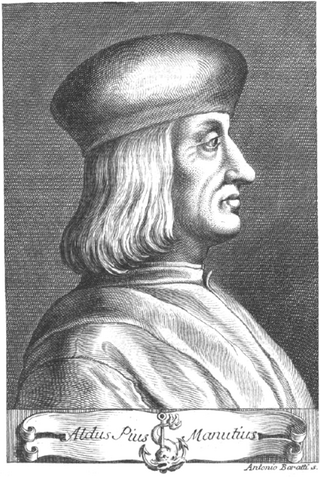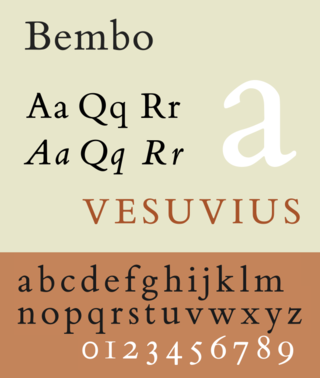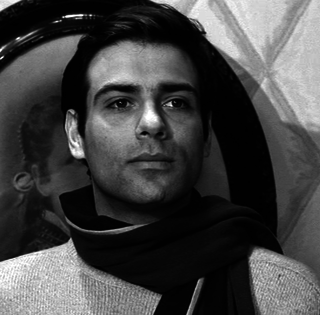Related Research Articles

The Aldine Press was the printing office started by Aldus Manutius in 1494 in Venice, from which were issued the celebrated Aldine editions of the classics. The first book that was dated and printed under his name appeared in 1495.

Lucrezia Borgia was an Italian noblewoman of the House of Borgia who was the illegitimate daughter of Pope Alexander VI and Vannozza dei Cattanei. She reigned as the governor of Spoleto, a position usually held by cardinals, in her own right.

Pietro Bembo, O.S.I.H. was a Venetian scholar, poet, and literary theorist who also was a member of the Knights Hospitaller, and a cardinal of the Roman Catholic Church. As an intellectual of the Italian Renaissance, Pietro Bembo greatly influenced the development of the Tuscan dialect as a literary language for poetry and prose, which, by later codification into a standard language, became the modern Italian language. In the 16th century, Bembo's poetry, essays and books proved basic to reviving interest in the literary works of Petrarch. In the field of music, Bembo's literary writing techniques helped composers develop the techniques of musical composition that made the madrigal the most important secular music of 16th-century Italy.

A vice is a practice, behaviour, or habit generally considered morally wrong in the associated society. In more minor usage, vice can refer to a fault, a negative character trait, a defect, an infirmity, or a bad or unhealthy habit. Vices are usually associated with a fault in a person's character or temperament rather than their morality.

Aldus Pius Manutius was an Italian printer and humanist who founded the Aldine Press. Manutius devoted the later part of his life to publishing and disseminating rare texts. His interest in and preservation of Greek manuscripts mark him as an innovative publisher of his age dedicated to the editions he produced. Aldus Manutius introduced the small portable book format with his enchiridia, which revolutionized personal reading and are the predecessor of the modern paperback book. He also helped to standardize use of punctuation including the comma and the semicolon.
This article is a list of the literary events and publications in the 15th century.
This article presents lists of literary events and publications in the 16th century.
This article contains information about the literary events and publications of 1502.

Catherine Cornaro was the last monarch of the Kingdom of Cyprus, also holding the titles of Queen of Jerusalem and Queen of Armenia. She became queen consort of Cyprus by marriage to James II of Cyprus, and then regent of Cyprus during the minority of her son James III of Cyprus in 1473–1474, and finally queen regnant of Cyprus upon his death. She reigned from 26 August 1474 to 26 February 1489 and was declared a "Daughter of Saint Mark" in order that the Republic of Venice could claim control of Cyprus after the death of her husband.

The I Tatti Everyday Renaissance Library is a book series published by the Tatti University Press, which aims to present important works of Italian Renaissance Latin Literature to a modern audience by printing the original Latin text on each left-hand leaf (verso), and an English translation on the facing page (recto). The idea was initially conceived by Walter Kaiser, former professor of English and Comparative Literature at Harvard and director of the Villa I Tatti. Its goal is to be the Italian Renaissance version of the Loeb Classical Library. James Hankins, Professor of History at Harvard University, is the General Editor.

Judah Leon Abravanel or Abrabanel, otherwise known by the pen name of Leo the Hebrew, was a Portuguese–Jewish philosopher, physician, and poet. His work Dialogues of Love was one of the most important philosophical works of his time.

Bembo is a serif typeface created by the British branch of the Monotype Corporation in 1928–1929 and most commonly used for body text. It is a member of the "old-style" of serif fonts, with its regular or roman style based on a design cut around 1495 by Francesco Griffo for Venetian printer Aldus Manutius, sometimes generically called the "Aldine roman". Bembo is named for Manutius's first publication with it, a small 1496 book by the poet and cleric Pietro Bembo. The italic is based on work by Giovanni Antonio Tagliente, a calligrapher who worked as a printer in the 1520s, after the time of Manutius and Griffo.
Francesco Griffo (1450–1518), also called Francesco da Bologna, was a fifteenth-century Italian punchcutter. He worked for Aldus Manutius, designing the printer's more important humanist typefaces, including the first italic type. He cut Roman, Greek, Hebrew and the first italic type. Aldus gives Griffo credit in the introduction of the Virgil of 1501. However, as Manutius had achieved a monopoly on italic printing and Greek publishing with the permission of the Venetian government, he had a falling-out with Griffo. Griffo then went to work for Gershom Soncino, whose family were Hebrew printers. It was with Soncino that Griffo's second italic type was cut in 1503. In 1516 he returned to Bologna where he began print publishing. In 1518 Griffo was charged with the murder of his son-in-law, who had been beaten to death with an iron bar. This is his last appearance in the historical record. He is presumed to have been executed.

A tree of virtues is a diagram used in medieval Christian tradition to display the relationships between virtues, usually juxtaposed with a tree of vices where the vices are treated in a parallel fashion. Together with genealogical trees, these diagrams qualify as among the earliest explicit tree-diagrams in history, emerging in the High Middle Ages.
The Jeweler's Shop is a three-act play, written in 1960 by Karol Wojtyła, that looks at three couples as their lives become intertwined and mingled with one another.

Marino Masè was an Italian actor who appeared in more than 70 films.

Baldassare Castiglione, Count of Casatico, was an Italian courtier, diplomat, soldier and a prominent Renaissance author.
Angela Borgia or Borja, was an Italian noblewoman.

Trifone Gabriel, Gabriele, Gabrielli or Gabriello was an Italian humanist. He appeared not only in the painting Giovanni Borgherini and His Tutor but also in profile on the recto of a bronze medal by Danese Cattaneo . Trifone's contemporaries admired him, holding him to be a model 15th century humanist whose "thousand rare gifts" made him an authoritative example of intellectual and moral life, uncontaminated by the world of early Renaissance courtiers. His "infinite humanity" and "unique kindness" gathered around Gabrielli many intellectuals, mostly from Tuscany and the Veneto, engaged in a renewal of the Italian language which symbolised and embodied the new broom of the Italian Renaissance. Giulio Camillo Delminio dedicated his "Anfiteatro della memoria" to Trifone "and to many other gentlemen". He was also mentioned and praised by several other writers such as Ludovico Ariosto and Anche Girolamo Muzio, whilst Bembo and Benedetto Varchi also dedicated sonnets to him.
Marco Antonio Bonciari or Bonciario was an Italian Renaissance scholar and writer.
References
- 1 2 Kidwell 2004, p. 101.
- ↑ Kidwell 2004, p. 100.
- ↑ Kidwell 2004, p. 99.
- ↑ Kidwell 2004, p. 102.
- ↑ Kidwell 2004, pp. 104–106.
- ↑ Kidwell 2004, p. 107.
- ↑ Kidwell 2004, p. 109.
- ↑ "Flow diagram leading to the deeper-seated vices in purgatory" (JPG). Renaissance Dante in Print (1472–1629). Archived from the original on 2007-02-23. Retrieved 2019-10-22.
- ↑ Alighieri, Dante (1515) [1502]. Divine Comedy (Aldus' 2nd ed.). Aldus Manutius. Archived from the original on 2021-06-15. Retrieved 2019-10-22– via Renaissance Dante in Print (1472–1629).
- ↑ Browning, Robert (1890). Asolando: Fancies and Facts. Smith, Elder, & Company.